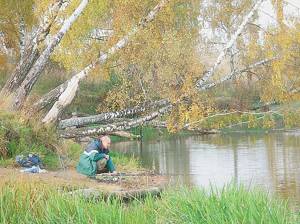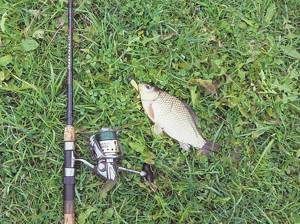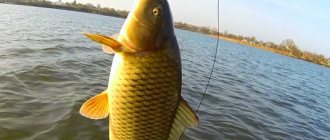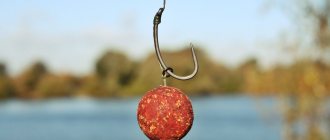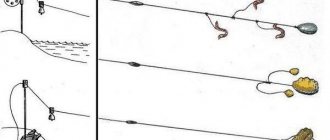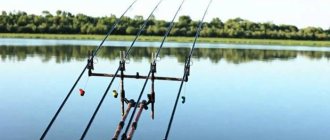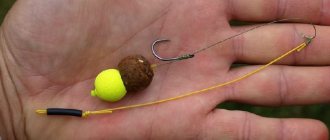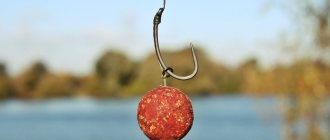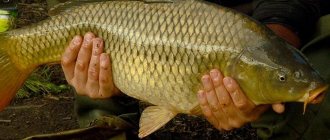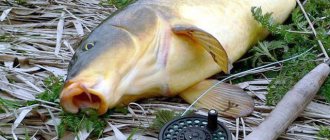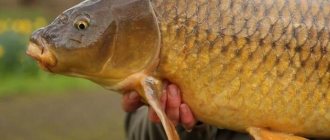What to fish with on the Volga, how to fish on the Volga, what baits to use when fishing on the Volga. Such questions are asked only by those fishermen who have not yet been fishing in the Astrakhan region. From the article, anglers will learn what kind of fish can be caught on the Volga in the summer, what gear to use for catching catfish, carp, pike perch, asp and other fish. We will tell you which rod to choose for fishing on the Volga, what reel you will need, help you decide on the choice of fishing line and reveal the secret of which lures work best when fishing on the Volga.
What to fish with on the Volga
In the summer, many fishermen dream of going fishing on the Volga. There are many reasons for this, because legends about trophy catches on the Volga have been circulating in the fishing community for a long time. Of course, fishing on the Volga is good: there is a bite and the fish are solid, but you shouldn’t expect that a bare hook will bite. Fishermen should understand that fishing has its own specifics depending on the region. Let's try to decide what to fish on the Volga with, how to fish on the Volga and what gear you will need for fishing on the Volga. We have already set the Fisherman's Calendar on the Volga and Akhtuba for June, July, August, in order to understand which fish will be caught better than others in the summer on the Volga (green - the fish bites well, yellow - the fish bites poorly, red - the fish does not bite).
| Fish | Fishing on the Volga in June | Fishing on the Volga in July | Fishing on the Volga in August | |||
| June 1-15 | June 16-30 | July 1-15 | July 16-31 | August 1-15 | August 16-31 | |
| Asp | ||||||
| Vobla | ||||||
| Rudd | ||||||
| Bream | ||||||
| Perch | ||||||
| Zander | ||||||
| Carp | ||||||
| Som | ||||||
| Pike | ||||||
Fishing gear on the Volga
From the angler's calendar it is clear that in the summer the roach does not bite eagerly, and pike and pike perch are also capricious. The rest of the fish are ready to pay attention to your fishing gear. This means that fishing gear on the Volga must be selected based on what kind of fish you are going to catch. As a rule, the choice of gear for fishing for a particular fish differs in the length of the rod, rod action, multiplier reel, spinning reel, etc., braided or monofilament fishing line of different diameters, baits used: wobblers, poppers, foam rubber, spinners, etc. . Let's figure out what gear is needed for fishing on the Volga for asp, what gear to catch catfish on the Volga, how to choose gear for fishing for carp, and also what gear for catching pike and pike perch to use when fishing on the Volga.
Advice from experienced fishermen
- Do not make noise. Carp are very cautious and timid, so any noise negatively affects the bite.
- Don't skimp on the amount of bait. Carp cannot be overfed, and in order to keep the school at the fishing point, a large amount of bait is required.
- Use a plant bait in the summer, and an animal bait in the spring and fall.
- Have plenty of different attachments with you. Carp is an unpredictable fish and it is impossible to say in advance what it will bite on today.
- Watch the wind. It has been noticed that in windy weather the carp bite increases.
- Use thick wire hooks. Although fish are caught better with thin hooks, large carp have dense, fleshy lips, and it is not difficult for them to straighten a thin hook.
You can ask your question to our author:
How to catch asp on the Volga
Tackle for asp
Tackle for catching asp should be selected based on the behavioral characteristics of this fish. Asp is a very cautious fish and catching asp on the Volga occurs with the help of long casting. It follows from this that the best tackle for catching asp on the Volga will be a spinning rod with a rod length of 3 to 3.3 meters. The action of the gear for asp is preferable from medium to medium-fast, the test of the cast bait is from 10 to 35 g. A monofilament line with a diameter of approximately 0.2-0.22 mm is suitable for catching asp on the Volga, but if you are a fan of braided line, then use braided line with a diameter of up to 0.13 mm. The tackle for an asp definitely needs to be set up and the clutch adjusted, since the asp behaves actively when fishing. As for the reel, a spinning reel of the 3000-3500 series from Daiwa and Shimano is suitable. When choosing gear for asp fishing, keep in mind that the asp often bites when the bait is retrieved super-fast, so pay attention to the high gear ratio of the asp reel.
The best baits for catching asp on the Volga
The best lures for asp fishing on the Volga are Kastmasters weighing from 14 to 27 grams; color can affect the bite; it is preferable to use wobblers with an orange or blue stripe for asp fishing on the Volga. The asp bites on spoons, jigs, and rotating spoons. The best bait for asp when fishing on boilers is surface wobblers.
What to use to catch catfish on the Volga
Catfish fishing gear
Catching catfish while fishing on the Volga is the dream of every fisherman. This Volga giant needs special gear to catch it. If you plan to catch catfish with a spinning rod from a boat, then you will need a rod with a fast action and a length of 2.4-2.7 m, a weight test of 40-80 or 50-100 g. A braid with a diameter of 0.2–0.3 mm will allow you to avoid breakage if you need to force fishing.
A spinning rod for catching catfish must be equipped with a Shimano Tecota 500 class multiplier reel. The equipment for catching catfish with a spinning rod can be used with a jig.
It is excellent to catch catfish when fishing on the Volga by trolling. Here, however, one should distinguish between deep-sea trolling for catfish in pits and riverbed edges; and shallow-water trolling for catfish on the rifts, where catfish come out in the second half of summer to hunt for saberfish. You can also catch catfish while fishing on the Volga in a plumb line, using a short, powerful rod up to 2.1 m long with a cast of 100 g, which should be equipped with a powerful multiplier reel.
The best baits for catching catfish on the Volga
The best lures for catching catfish by trolling in deep areas are Storm Deep Thunder wobblers with a length of 11 to 15 cm (immersion depth 5.5 - 9 meters), floating wobblers MANN'S and Halco (immersion depth 7 to 9 meters) are also suitable. Wobblers for catfish for depths from 10 to 13 m are MANN'S and RIVER 2 SEA class 30+. Fishing for catfish in July-August on shallow reaches and riffles will require the use of wobblers with a diving depth of 1.5 to 2.5 meters, as an option - the universal wobbler Storm Hot'n Tot, suitable for catching any predatory fish on the Volga.
In principle, to catch catfish on the Volga in shallow water, you can use any floating wobbler equipped with a rattle and reliable tees. Catching catfish on the Volga with a jig involves using a sinker head weighing from 40 to 80 grams to feel the retrieve and the bait touching the bottom, since catfish fishing is done in holes and at great depths with a noticeable current. It is better to catch catfish using such baits as: large vibrating tails, large twisters, foam fish up to 15 cm long. It is extremely important when catching catfish to use a metal leash so that the brush made of catfish teeth does not fray the braid during long-term fishing. Remember, the main thing when catching catfish on the Volga is the strength of all elements of fishing gear.
Catching carp in the fall
Photo: Anatoly Mailkov.
For some reason, the opinion persists that in cold water, heat-loving fish stop feeding, move to the deepest places and lie down there for the winter.
And the story continues to exist that crucian carp generally buries itself in the bottom silt, where it goes into suspended animation for the entire winter.
This is generally absurd, since any living organism needs oxygen at least in minimal quantities, and in muddy deposits there is none at all.
But the seasonal behavior of any fish is connected not so much with the temperature of the water, but with the entire complex of living conditions that have developed in a particular body of water.
In addition, the habits of various fish, including carp and crucian carp, are largely determined by age and size.
But about everything in order and in contrast to the above opinions, which probably arose and took root under the influence of old fishing literature.
Here you need to understand that fifty to a hundred years ago the climate of the middle zone was much harsher than it is now, and they did not deeply study the behavior of fish, often passing off hypotheses, rumors and assumptions as truth, because there was apparently a lack of objective information .
In addition, much of the information related to the lifestyle of red or golden crucian carp, as well as carp, raised on a fish farm on free food served on a schedule, while the fish were almost not accustomed to searching for and consuming natural food that varied in different seasons.
Currently, the situation in many reservoirs is such that you can almost no longer see golden crucian carp in them - it has been almost completely replaced by silver crucian carp, which leads an active life all year round, and therefore does not stop feeding.
This is especially evident in those ponds, lakes and quarries where, even in relatively harsh winters, a normal oxygen regime is maintained, allowing not only crucian carp, which are unpretentious in this regard, to survive, but also roach, perch, pike, and other fish that are sensitive to water quality, including including the “wild” carp, which was released into the wild.
It is in such reservoirs, which, as a rule, are distinguished by significant depths, flow to varying degrees or the presence of a large number of springs, and, moreover, densely populated with fish of various species, crucian carp and carp retain sufficient mobility until freeze-up.
Read the material “Remembering the Golden Autumn”
This relatively high activity is necessary for them to search for food. This is due to the fact that here they experience constant competition from fellow animals and numerous small items and do not have time to accumulate the required amount of fat. Therefore, in cold water they often consume food that is unusual for them, in particular, sometimes they become ardent predators, massively exterminating fry or the small fish that predominate in the reservoir, for example, verkhovka, gudgeon or bitterling.
This circumstance must be taken into account by the fisherman when selecting effective attachments or baits for catching crucian carp and crucian carp in late autumn, while taking into account the repeatedly proven fact that the larger the fish, the more prone it is to a predatory lifestyle.
|
| Photo: Anatoly Mailkov. |
And in this regard, we can cite many cases from our own fishing practice and information from modern publications, when on one of the ponds in the late autumn of “wild” carp, which had reached a weight of only two kilograms, it was possible to successfully catch with a fishing rod exclusively on the top - live or dead , but fresh, just mined in this reservoir.
And in the southern regions, where numerous ponds abound not only with carp and crucian carp, but also carp, grass carp, and silver carp, it has become common practice in cold water to effectively seduce large fish by placing compact pieces of cut gudgeon on the hook. By the way, almost all predators and, apparently, not only them, have a clear predilection for it in cold water.
In addition, modern fishing techniques with feeder gear involve the use of special multi-component boilies as bait.
Read the material “The influence of smell on biting”
So, catching large carp in cold water often gives excellent results if quite a lot of minced meat is added to the mixture for homemade boilies, which, of course, indicates the autumn orientation of the fish towards food of animal origin.
Apparently, when the temperature of the habitat decreases below a certain threshold value for each fish, it can no longer quickly obtain the necessary energy from plant food, which takes a long time to be absorbed by a cold-blooded organism. But any living creature consumed by fish under the same conditions gives more energy per unit of its own weight and decomposes in the digestive organs in less time.
Where there are a lot of carp and it makes sense to engage in special autumn fishing, when the water has cooled, they gather in fairly deep areas of the reservoir, where the water is somewhat warmer than in shallow waters.
Therefore, in the fall, for fishing, it is better to choose ponds that are large in size, characterized by steep changes in bottom relief, which ensures the formation of zones of local concentration of fish.
Here, somewhere closer to the middle of the day, the carp begins to actively dig into the bottom sediments, looking for bloodworms and picking up other animal food, and, naturally, it is then easy to seduce with a worm, a bunch of bloodworms and maggots, or a “sandwich” of them on a hook.
As for the gear, a float rod with rings and a reel, an extremely light, rough bottom with a feeder, and a sensitive pickerel with just a weight and one or two leashes are suitable - the tackle is not so important, the main thing is to accurately hit the fish site.
The success of fishing will also be facilitated by light bait, thrown into the right place long before the fish come out to feed - it is now designed not to attract carp from somewhere far away, which is almost useless in the fall, but only to encourage it to search for food and move.
Read the material “A long fight with carp - the wife’s view”
It is important not to overdo it with flavorings in bait, which is unacceptable in clean autumn water. By the way, it has been noticed that carp and crucian carp are very well attracted by soil dug up in the meadow and added in fair quantities to the bait.
|
| Photo: Anatoly Mailkov. |
PREDATORY HABITS
If we move a little away from the traditional fishing of crucian carp and crucian carp with the usual gear, then we should touch on the facts of accidental and even purposeful catching of these fish with a spinning rod using artificial bait when hunting for pike or perch in the autumn.
An experienced fisherman can always understand who owns the neat “pokes” that suddenly begin in some place in the reservoir, unusual for common predators. In this case, you should not throw a position from which there seems to be contact with the fish, but it does not sit on the hook, but it is better to try to experiment both with the selection of bait and with the method of its animation.
Read the material “Frogs are an excellent animal bait”
As a rule, large carp and even crucian carp can still be lured into the right bite if you use an extremely compact imitation of minimal weight, which, while playing, falls to the bottom for quite a long time after casting - it is at this moment, which is called “flight”, that there are many bites carp
Then, when the bait has reached the bottom, its retrieval begins, usually in steps with a high rise at each stage and a time-consuming drop down, which is precisely what makes it possible to keep its weight to a minimum.
And it doesn’t matter what type of imitation is used - it can be the smallest spinner, combined in front with a “eared” weight (jig-spinner), or a suitable-sized twister or vibrotail, or a narrow foam fish.
In this case, the technical execution of step-by-step wiring presupposes that the pace of bait delivery is slowed to the limit, since carp and crucian carp in cold water are very leisurely and confidently grab only what, as they say, fits into the mouth itself.
The most important technique in this technique is to briefly drag the bait along the bottom, forming a cloudy trail behind it, before it rises into the water column on the next “step.”
Such behavior of potential “food” most often leads to a confident “pressure” by carp or crucian carp, when the bite is felt like a soft pull or a moving hook. Then, when the fish hits the hook, a powerful pull will follow, especially if it concerns carp, so the fisherman needs to be prepared and adjust the friction brake on the reel in advance.
Otherwise, on the most dangerous first throw, the fish will either break the thin line that is needed for a small bait, or bend or break the small hook corresponding to the bait, and may also tear its lip - in any case, an enviable and rare trophy will be lost.
If you managed to parry the first jerk, then you don’t have to rush too much and don’t force the fight when there is no snag nearby.
Read the material “Huge boars of Turkestan”
It is better not to take the carp by force, since it has sensitive and painful lips, so more rapid throws will follow, which are always summed up by the impact on all elements of the tackle and can lead to an offensive loss of fish at the final stage.
Anatoly Mailkov September 22, 2021 at 02:27 pm
What to use to catch carp on the Volga
Tackle for catching carp
Catching carp on the Volga requires the use of durable gear.
Fishing for carp, a strong and cunning fish, is always a struggle. Fishing for carp brings a lot of thrills, so the tackle should be as reliable as possible. Professionals use carp fishing gear for carp fishing: carp rods, carp reels and a stand with an electric bite alarm. Of course, gear for carp is expensive, so if you really want to try to catch carp, then a converted spinning rod with a dough of 40-80 grams and a length of 2.7-3.3 meters is suitable for catching carp on bottom gear.
It is advisable to use a reel for carp from Shimano with a Bait Runner system of the 6000-10000 series, but you can also get by with Daiwa reels of the 4000-5000 series. For carp, a braided line with a diameter of 0.2-0.3 mm is preferable, but monofilament with a diameter of 0.4-0.5 mm can also be used. Monofilament line fends off jerks much better when fishing for carp. Also, for fishing for carp on the Volga, you will need weighty sinkers for bottom equipment and durable hooks for catching carp weighing from 4 kg.
The best baits for catching carp on the Volga
The best baits for carp are boilies and barley shell meat. To improve the bite when fishing for carp on the Volga, you can use carp bait.
Carp fishing
Sports carp fishing, or carp fishing, originated in England. In our country, this type of fishing is also becoming increasingly popular. The philosophy of carp fishing is to catch trophy carp using modern gear, as well as the “catch and release” principle.
Carp fishing differs from ordinary amateur fishing in the large number of original accessories, as well as a humane attitude towards the caught fish. A weighing bag, a special mat for caught fish, a landing net with a soft mesh that does not harm the carp, electronic bite alarms, rod pods, slingshots, catapults - this is just a small list of the attributes of a modern carp angler.
Typically, carp fishing involves trips for several days. After arriving at the fishing site, the first thing to do is organize everyday life - set up a tent, cot, chairs and other attributes of a fisherman, and only then prepare the gear.
Then, using a marker rod, a promising section of the bottom is searched. Having found such an area, a beacon is thrown there and the fishing point is fed. A slingshot is used for feeding at close distances, and a catapult or rocket at long distances.
After feeding the points, the first tackle is thrown. The beacon is removed, and all of the above steps are repeated for the next gear. Typically, carp fishing uses at least two to four rods.
After catching the trophy, it is photographed and carefully released back into the water.
How to catch pike perch on the Volga
Tackle for catching pike perch with jig
Fishing on the Volga for pike perch is one of the most exciting, especially since the methods of catching pike perch are varied. Let's figure out what gear is needed for fishing for pike perch.
To catch pike perch with a jig, you will need a fast rod 2.7-3 m long with a cast of 15-40 or 20-50 g. The main weight of jig heads for catching pike perch on riverbed edges and dumps is in the range from 35 to 50 grams. As for catching other predatory fish on the Volga, for fishing for pike perch it is better to use braided fishing line with a diameter of 0.15-0.19 mm. A reel for pike perch would be appropriate from the 3000-3500 series from Shimano or Daiwa. This condition will allow you to combine fishing for pike perch with fishing for small catfish on the Volga.
The best baits for catching pike perch on the Volga
The best baits for pike perch on the Volga are foam rubber fish, vibrotails and twisters equipped with doubles or tees.
The preferred bait color for pike perch is green and fluorescent green. It takes pike perch well and baits of orange and yellow shades.
If you plan to catch pike perch in snags, choose foam rubber with hooks pressed tightly to the body or twisters on an offset hook with a recessed sting as bait. The pike perch has a hard mouth, so when biting it easily breaks through the silicone, exposing the hook tip.
How to catch pike perch on the Volga
Tackle for catching pike perch by trolling, catching pike perch on the track
The gear for catching pike perch by trolling as pike perch on the Volga is almost identical to the gear for catching catfish with a spinning rod, so the recommendations for spinning rod, reel, fishing line and wobblers are similar to those we gave above in relation to catching catfish.
The best baits for catching pike perch on the Volga
The best lures for catching pike perch by trolling on the Volga are wobblers of various colors, depending on the time of year chosen for fishing on the Volga:
- in the spring, pike perch are caught using wobblers with a natural color that imitates carp fish - a dark back, a white belly and silvery sides;
- In summer, pike perch are perfectly caught using wobblers of greenish shades, for example: plain green and green with transverse stripes for perch. Another universal option is the coloring of the Red Head wobbler - red head, white body. In addition to pike perch, pike are excellent fish for this coloration.
With a wobbler up to 15 cm long you can catch a luxurious trophy specimen of pike perch on the Volga. For catching pike perch at a depth of 10-13 meters, wobblers from MANN'S Magnum Stretch 30+ and RIVER2SEA downsider minnow 200f are suitable. But just in case, take slightly smaller wobblers with an elongated shape when fishing. In some cases, biting on a smaller wobbler turns out to be more interesting. Also, for fishing on the Volga, it is recommended to use wobblers from the manufacturer Halco, which are used not only by pike perch, but also by catfish.
How to catch pike on the Volga
Pike fishing gear
Pike fishing on the Volga is good in the cool season; in summer the pike is a little bit fishy and to catch it you will have to use the best pike tackle. More often in the summer they catch pike not on the river itself, but in lakes and eriks, near thickets of grass.
Therefore, when choosing gear for catching pike on the Volga, choose a rod 2.7 meters long with a test weight of 10-30 g; it is advisable to choose a medium-fast action for pike, this will allow you to catch pike with both floating wobblers and jig baits. A reel for pike fishing is suitable for a spinning reel of the 3000 series. A metal leash is required when fishing so as not to lose your favorite wobblers and spinners when fishing for pike. Of course, to catch pike on the Volga, use strong and elastic braid with a diameter of up to 0.13 mm.
The best lures for pike fishing on the Volga
The best lures for pike are floating wobblers with a diving depth of up to 3 meters and a size of up to 13 cm. In lakes overgrown with grass, you can use poppers and spinnerbaits. Slugs and Texas rigs work well on toadstools. You can use non-snagging Rapala Minnow Spoon spinners, as well as Mepps and Daiwa spinners converted to non-snagging spinners. Homemade non-hook fishing gear is a vivid example when DIY fishing gear gives tangible results when fishing in the grass.
Fishing on the Volga should certainly please you with trophies. We suggested what fishing gear for fishing on the Volga in the summer can be used to catch various fish, what baits fish on the Volga bite best, what kind of fish and how to catch... The rest depends on your fishing skills and fishing luck. Have fun fishing on the Volga and have the necessary gear at hand!
Stepan Shevchenko
Source
Fishing on canals and streams
It is much easier in the autumn to catch carp on canals and creeks. This is a semi-anadromous or anadromous carp. It follows from spawning grounds and summer feeding grounds to wintering pits. Usually he does not stay long in one place, even when moving in a flock. Bait when catching such fish is not very effective, and carp fishing in such places cannot be considered classic. However, in narrow channels the probability of meeting fish at one point is much higher than searching for it over a vast area of a lake, bay or pond.
Carp fishing here may use a slightly different technology. Usually “carp” places near the coast are overgrown with reeds. When approaching a fishing spot where there is an open channel near the water, you should wear knee pads. The fishing rod also often has to be placed on complex stands to prevent the reel from ending up in the water. Usually it is installed almost vertically on a special stand.
The casting distance for this kind of fishing is usually short; the fish are fed by hand. They will know about a bite when the alarm goes off. Most often this is a bell, but sometimes electronic and other alarms are used. Fishing is usually carried out with no more than three or four shortened fishing rods, up to two meters. This type of fishing is popular in many southern regions of Russia and is not as expensive as full-fledged English carp fishing. It is used both on small rivers and canals, and on eriks in the lower reaches of the Volga and Ural, where you can find a sufficient number of carp in the fall. However, there is no need to skimp on equipment here. Although the rods themselves are simpler and their number is smaller, good hair equipment, good hooks and fishing line are the key to a good catch.
